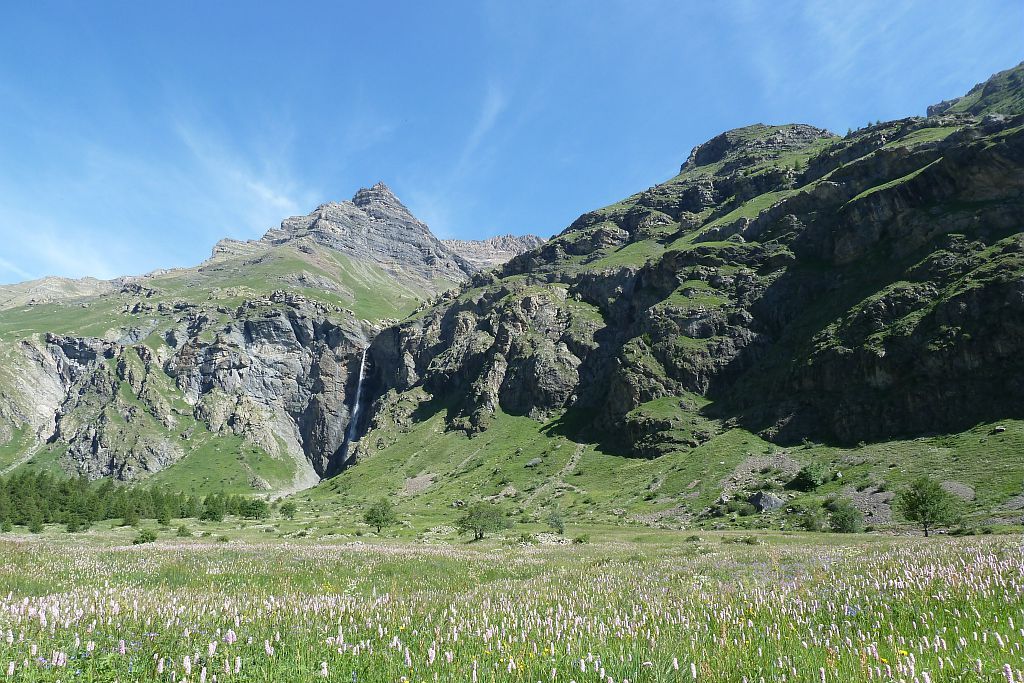
Le col de Freissinières
"Whilst coming down from the Fressinières pass one July morning, where there were still névés on the the slopes that had the least sun, two animals were running in the snow. Two roe deer at 2500 metres in altitude! What fantastic adaptability! »
Blandine Delenatte and Jean-Philippe Telmon, wardens
Description
From the Cascades Car Park, take the path to the left, where you will find the entrance to the National Park, indicated by three explanatory panels (Leave the bridge that leads to the winter trail to the right). Cross the footbridge over the Oules stream and follow bends in the path along a large waterfall before crossing a zone of scree. As this 'summer' trail crosses an avalanche zone, it is not used in the winter. It has a gentle slope and is wide, enabling the inhabitants of Dormillouse to restock with the help of tracked wheelbarrows.
- At the following junction, stay on the track to the right (the one to the left leads to the Fangeas lake and the Terres Blanches pass).
- Follow the trail towards Dormillouse and before the footbridge, turn left following the signs for lac Faravel, lac Palluel, Fressinières pass.
- When you come to the next fork in the road, take the footpath to the right towards the Fressinières pass.
- When you arrive on the Arduin plateau, carry straight on at the 4 roads crossroads towards the Fressinières pass. The trail enters the forest of larch and follows the right bank of the Biaysse climbing up to the Chichin valley. It crosses the Chichin glacial cross-cliff by means of a small footbridge, reaches the pastoral hut, continues along the edge of the Lauzeron lake then weaves in and out of the moraines until it reaches the pass.
- The return trip is made by the same route. It is also possible to reach Prapic and return via the Terres Blanches over 2 days.
- Departure : Cascades Car Park, FressinièresCascades Car Park, Fressinières
- Towns crossed : Freissinières
Altimetric profile
Recommandations
No camping in the Cascades Car Park (including inside a vehicule), bivouac permitted at least an hour's walk away from the park boundaries.
No campfires in the heart of the Park.
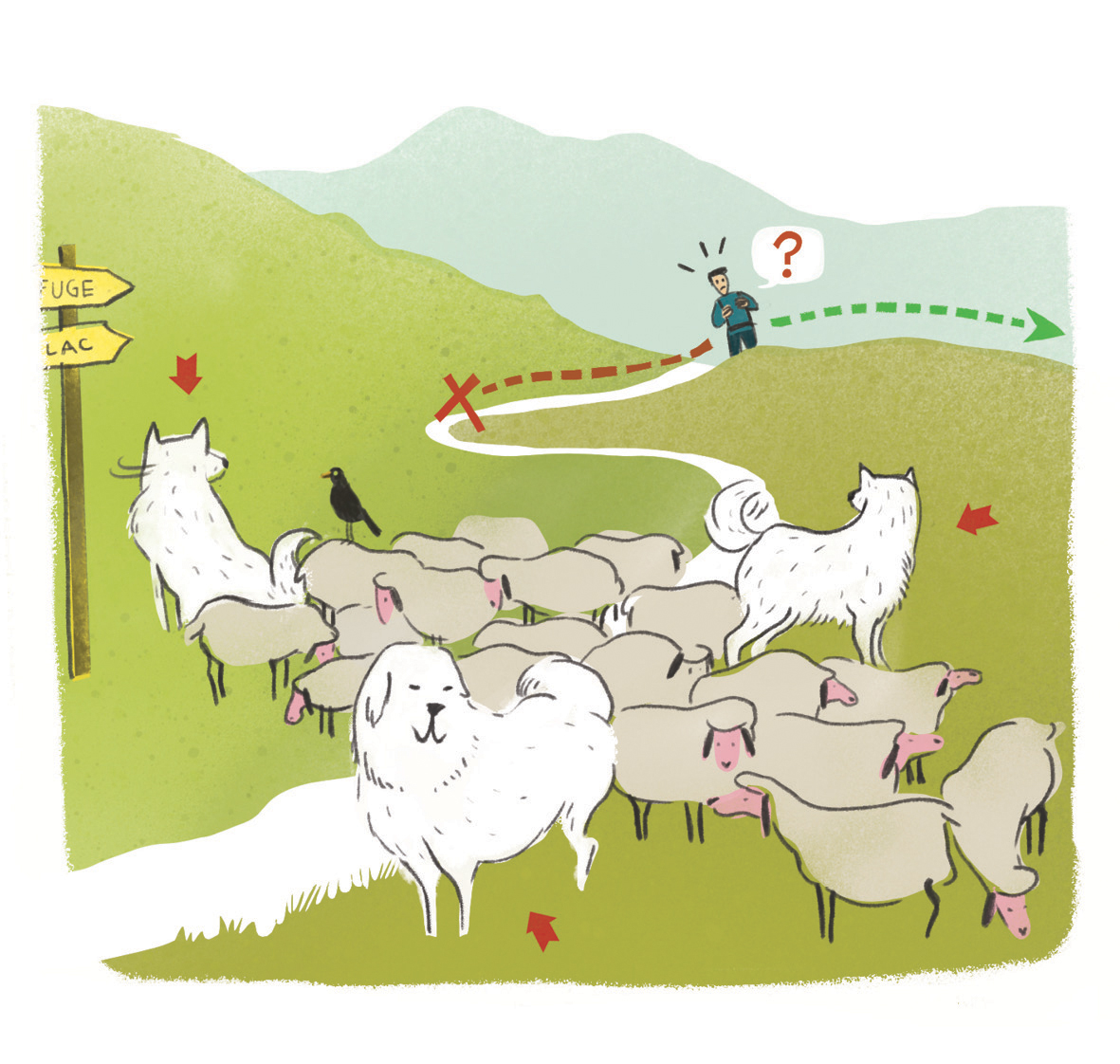 In mountain pastures, protection dogs are there to protect the herds from predators (wolves, etc.).
In mountain pastures, protection dogs are there to protect the herds from predators (wolves, etc.).
When I hike I adapt my behavior by going around the herd and pausing for the dog to identify me.
Find out more about the actions to adopt with the article "Protection dogs: a context and actions to adopt".
Tell us about your meeting by answering this survey.
Transport
Nearest SNCF train station: l'Argentière les Ecrins - www.voyages-sncf.com then taxi. (Taxi Pellegrin 06 98 88 17 78 / Taxi Billau 06 08 03 45 90)
Access and parking
From the main RN94 road north of la Roche de Rame, head towards Fressinières on the D38 then D38B roads. Go through Fressinières and follow the D238 road, which heads right up to the Cascades Car Park on the valley floor. This is the end of the road in the bottom of the Fressinières valley. In the snowy season, the road is closed.
Parking :
Sensitive areas
Golden eagle
- Impacted practices:
- Aerial, , Vertical
- Sensitivity periods:
- JanFebMarAprMayJunJulAug
- Contact:
- Parc National des Écrins
Julien Charron
julien.charron@ecrins-parcnational.fr
Black grouse - winter
- Impacted practices:
- , Land
- Sensitivity periods:
- JanFebMarAprDec
- Contact:
Black grouse - winter
- Impacted practices:
- , Land
- Sensitivity periods:
- JanFebMarAprDec
- Contact:
- Parc national des Ecrins - 0492402010
16 points of interest

 Archaeologie
ArchaeologieMines
A few remains of the exploitation of the ancient mine are disseminated around the sector of Fangeas. These mines go back to the Middle Ages, a period during which we exploited silver-lead and copper. It was a small exploitation, no doubt associated with the mines at Fournel. The metal mined was used to mint feudal currency. The mine works are now filled in and flooded, which has enabled us to find well preserved remains: scaffolding, turned wooden bowls, the sole of a shoe. Archeologists have been excavating the mine for the last ten years they started by siphoning off the flood water from the tunnels. The mines are not accessible to the public and we have deliberately not communicated their exact location. For more information about this heritage, contact the mining museum at l'Argentière la Bessée.
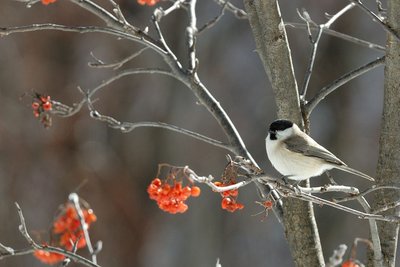
Mésange nonette - PNE - Coulon Mireille  Fauna
FaunaMarsh tit
This discreet tit is often confused with the mountain wollow tit. Distinguishing them is not easy. The bib of the marsh tit is smaller than that of the wollow tit; its wings are solid brown whereas they are slightly lighter for the wollow tit. Its crown is shinier. It is sedentary and visits the cooler deciduous forests, groves and garden providing there are trees with holes for nesting. It rarely goes higher than the mountain stage except for the most exposed sectors. With the arrival of spring, it does not come out of the old ash tree much. The best idea is to listen: the song and the call of the tit are very loud and tonic. Even then, it is not easy as it changes the song as if teasing the amateur ornithologist.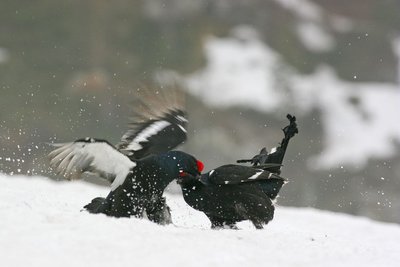
Combat de tétras lyres au printemps - PNE - Chevalier Robert  Fauna
FaunaBlack Grouse
You will need to get up early if you want to see the Black Grouse in the summer. In France, the Black Grouse, or capercaillie as it is also known, can only be found in the Alps. The emblematic Black Grouse completes its biological cycle at the upper limit of the larch forest with springtime parades where the males coo and tackle each other, summer nesting supervised by the females and a winter lodging dug out of the snow. In winter, the Black Grouse is particularly sensitive to disturbance, such as an off-piste skier or snow-shoer passing by, as it cannot compensate for the energy lost should it need to flee its igloo in a hurry.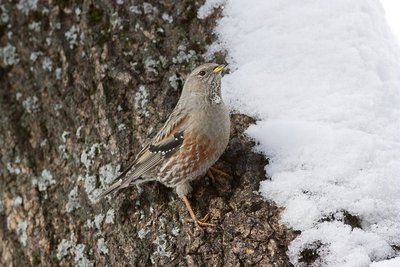
Accenteur alpin - PNE - Chevallier Robert  Fauna
FaunaAlpine Accentor
An inveterate mountain-dweller, the alpine accentor is a sturdy passerine bird with a plump belly. A few black lines appear in its ashy feathers. It is characterised by the ginger flames on its sides. Found typically in the alpine prairies, it scampers across the short grass and crows on the bare stone. It comes to peck at the crumbs around the mountain refuge. When winter comes, it migrates towards the valleys. Its migration can even lead it as far as the rocks on the coast. When the snow melts, it is a formidable predator of small invertebrates numbed by the cold along the névé. It also gleans seeds, berries and small plants, explores the ledges, rummages in the cavities, and totters about, unsuspicious of its archenemy the hawk.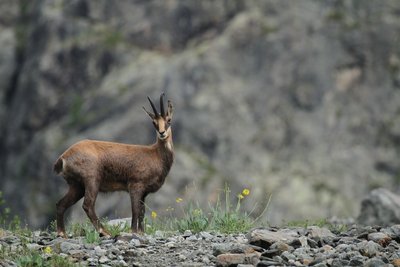
Chamois - PNE - Telmon Jean-Philippe  Fauna
FaunaChamois
Emblematic animal of the Alps, the chamois, or "rock goat" have short black hooked horns. As with the ibex, they are easier to observe using binoculars. The females and the "éterlou" (young male under one year old) like to stay in a large herd whereas the males are more solitary and join the females for the mating season. In winter, the chamois hope for calm as they need to keep their reserves of fat to survive.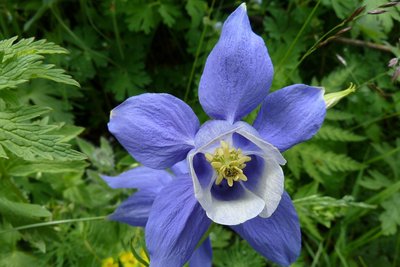
L'ancolie des Alpes (aquilegia alpina de son nom scientifique) - Blandine Delenatte - PNE  Flora
FloraAlpine Columbine
In the undergrowth of the larch forest, beside the footpath that follows up the Biaysse, large blue flowers catch the eye. The Alpine Columbine is an infrequent species. Its splendour is equalled only by its rarity. It has few sky-blue flowers, which make it easy to distinguish from the garden columbine that has smaller, more numerous purple-blue flowers. Columbine flowers are the only ones to have five spurs, the ends of the five petals are like a cornet guarded by five sepals shaped like a lance.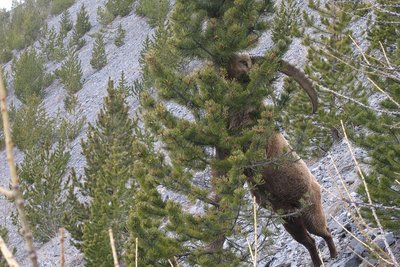
Bouquetin mâle qui mange des aiguilles de pin - Cyril Coursier - PNE  Fauna
FaunaThe alpine ibex
In 1995, several ibex were introduced into the Champsaur. Since then, their population has steadily progressed to the valleys of the massif. The females regularly give birth in the bars dominating the sunny side of the Prés Baridons, and the males come from the Champsaur to visit them via the Fressinières pass. Their coat mingles with the colour of the cliffs on which they tend to perch, which make them difficult to see without the help of binoculars or a telescope.
Lis martagon jouant au grè du vent - Ludovic Imberdis - PNE  Flora
FloraTurk's cap lily
More common than the alpine columbine, the Turk's cap lily's purple punctuated pink flowers blossom in the same undergrowth. When they are fully grown, the flowers bow to the ground with their six petals curving upwards, revealing six orange stamen. They will straighten with the growth of the fruit, an oblong capsule that opens lengthwise by three tears.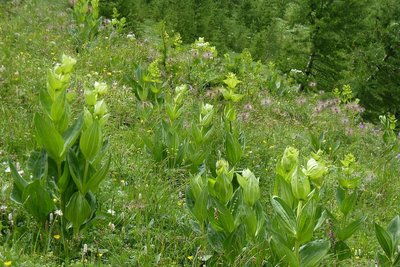
Gentiane jaune prêtes à éclore - Blandine Delenatte - PNE  Flora
FloraYellow gentian
Well-known for the invigorating, digestive, depurative properties of its roots, the yellow gentian is easy to recognise due to its opposite leaves that form a cup in which snuggle the fine yellow flowers. On the other hand, the white hellebore, that looks similar, has leaves that spiral up the length of the stem and never form a cup. Tradition claims that the height of the yellow gentian is a forecast of the depth of the snow the following winter.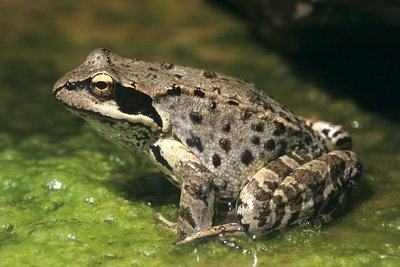
Grenouillle rousse - Mireille Coulon - PNE  Fauna
FaunaCommon frog
This is the most common frog in the Alps. It is sturdy, round-faced with a lovely temporal, chocolate-coloured mask that highlights its golden eyes. It is the only frog to occupy the wetlands above 1000 metres in altitude. The shallow, Lauzeron lake, is home to adults and tadpoles. The speed of their growth is determined by the altitude and climatic conditions. Here, conditions are harsh and they spend a year in water before they become young frogs, whereas 3 to 4 months are sufficient for this metamorphosis in the plains once the summer arrives.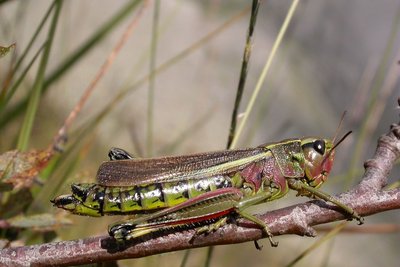
Le criquet ensanglanté aux couleurs caractéristiques - Blandine Delenatte - PNE  Fauna
FaunaLarge marsh grasshopper
In the wetlands that boarder the trail, little 'clicks' give this large “blood” grasshopper (criquet ensanglanté in French) away. Blood? Do not panic, like all grasshoppers, it is a vegetarian. This term simply describes the purple patches on the olive green and black body of the female. They only lay their eggs in waterlogged ground, as their eggs are very sensitive to dryness. This grasshopper, whose population is regressing in Europe, is therefore a good indicator of the quality and purity of the wetlands.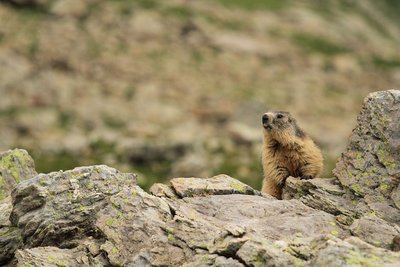
Marmotte des Alpes - Jean-Philippe Telmon - PNE  Fauna
FaunaMarmot
Close to a footpath, they will sometimes pose nonchalantly for a photo. The marmot's main strategy in face with of its predators (golden eagle, fox) is to take refuge in its burrow. They live in families made up of a couple of dominant adults and subordinates from successive litters. Grooming, games and fights ensure the cohesion of the group and the respect for the hierarchy. All participate in the delimitation of the territory by urinated or defecating at the boundaries or by rubbing their cheeks against the rocks in order to leave their scent.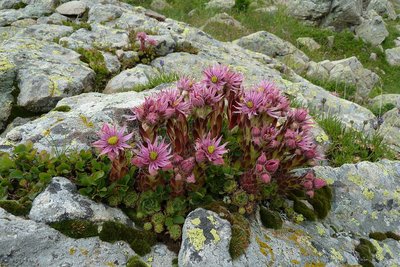
Bouquet de joubarbe des montagnes - Blandine Delenatte - PNE  Flora
FloraMountain houseleek
Houseleeks are stary flowers that open up above a miniature artichoke gripping onto a rock. To distinguish them from one another, look at the colours: brght pink for the cobweb houseleek whose artichoke is striped with white threads, dull pink for the common houseleek with its long, thick stem and antique pink for the mountain houseleek that is entirely covered with fluff made up of short, glandular hairs that smell like resin.
Niverolle alpine avec son repas dans le bec - Damien Combrisson - PNE  Fauna
FaunaSnowfinch
Just below the Fressinières pass, a group of quick-flying squawking birds come close to the footpath. Light coloured feathers, white, black-tipped wings, white tail with a black line in the middle. There is no doubt. It is a snowfinch. All year round, they stay at a high altitude, fearless of the cold! In winter, they spot the summits where the snow has been blown away and the bare vertical rock faces. If there is a heavy snowfall, they will head down the valley looking for seeds and berries.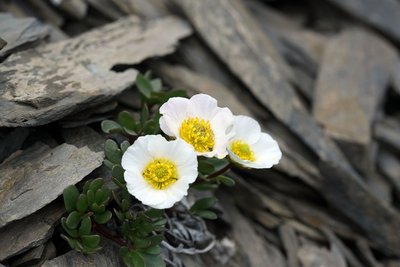
Fleur de renoncule des glaciers - Cédric Dentant- PNE  Flora
FloraGlacier buttercup
This small plant is in competition with lichens as it holds the record for highest altitude for a flowering plant in Europe! How has it adapted? It has a dwarf habit, the calyx and corolla remain after blossoming in order to protect the seeds, it has few fleshy leaves that can stand freezing and a capacity not to blossom the years where there is heavy or long-lasting snow.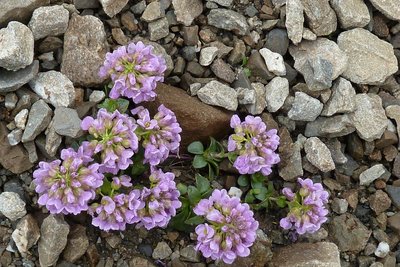
Tabouret à feuilles rondes - Blandine Delenatte - PNE  Flora
FloraRound-leaved penny cress
The round-leaved penny cress has chosen to settle in the scree below the Fresssinières pass, and uses its numerous shoots to survive in such an unstable and inhospitable environment. The attractive flowers that grow in balls brighten up the stone with a touch of lilac-pink. At the base, small, fleshy almost round leaves form rosettes.
Source

Report a problem or an error
If you have found an error on this page or if you have noticed any problems during your hike, please report them to us here:

